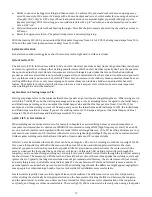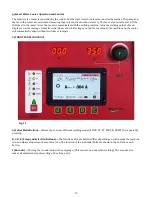
4
3) SAFETY SUGGESTIONS
It is forbidden for people with PACEMAKERS to use or come near the machine. When welding near sensitive
electronics, for example in hospitals or assisted living homes or around computers or computer control
modules in vehicles, we STRONGLY recommend turning off HF (high-frequency arc start). Even an AC arc on a
modern inverter can be ignited in lift-arc mode! HF travels long distances, 10 to 20 feet are very common in
some instances, and HF can interfere with electronics in neighboring buildings if they are on the same
transformer! Unlike regular welding currents, that travel the path of least resistance, HF is unpredictable.
Electric arc welding produces ultra-violet rays, which are harmful to skin and eyes.
Ultra-violet radiation can
penetrate lightweight clothing, reflect from light-colored surfaces, and burn the skin and eyes.
Wear a heavy, pocket-less, long-sleeved shirt, cuff-less trousers, and high-topped work shoes.
Wear a full-faced welding helmet with a number ten or darker lens and a cap.
Electric arc welding produces flying sparks and hot material, which can cause fire.
To avoid fire, do not weld on wood, plastic tile, or carpeted floors. Concrete or masonry floors are safest.
Do not weld on pressurized containers.
Do not weld on drums, barrels, tanks, or other containers until they have been cleared and cleaned as described in
AWS Standard A6.01.
Do not wear flammable materials.
Wear non-oily/non-greasy, flameproof welding gloves; the oil or grease on the gloves may ignite.
Avoid having any type of fuel, such as cigarette lighters or matches, on your person as you weld.
Ensure that there is a fire extinguisher in the welding area.
Electric arc welding produces toxic fumes.
Provide adequate ventilation in the welding area at all times.
Do not weld on galvanized zinc, cadmium, or lead beryllium materials unless you are POSITIVE that sufficient
ventilation is provided. These materials produce toxic fumes.
Do no weld in areas close to degreasing or spraying operations. Chlorinated hydrocarbon vapors may react with
the ultra-violet rays and form highly toxic phosphate gas.
If you develop eye, nose, or throat irritation during welding, stop welding immediately. This is an indication that
ventilation is not adequate. Do not continue to weld until ventilation is improved.
ELECTRIC SHOCK CAN KILL.
Exposed, electrically hot conductors, other bare metal in the welding circuit, or ungrounded, electrically hot equipment
can fatally shock a person whose body becomes a conductor. Do not stand, sit, lie, lean on, or touch a wet surface when
welding.
Disconnect the power supply before working on the welding machine.
Do not work with deteriorated or damaged cables.
Frequently inspect cables for wear, cracks, and damage. Replace those with excessively worn insulation to avoid a
possible lethal shock from bared cable.
Do not touch bare electrical parts.
Ensure that all of the panels covering the welding machine are firmly secured in place when the machine is
connected to the power supply.
Insulate yourself from the workbench and from the floor (ground); use insulating footwear and gloves.
Keep gloves, footwear, clothes, the work area, and the welding equipment clean and dry.
Check the machine power cable frequently; the power cable must be free from damage to the insulation. BARE
CABLES ARE DANGEROUS. Do not use the machine if the power cable is damaged; a damaged power cable must be
replaced immediately.
If it is necessary to open the machine, first disconnect the power supply and then wait Five (5) Minutes to allow the
capacitors to discharge. Failure to take this precaution may expose you to the dangerous risk of electric shock.
Содержание Invertig 313
Страница 6: ...6 Fig 1 ...
Страница 33: ...33 12 WIRING DIAGRAM Invertig 400 AC DC ONLY ...
Страница 34: ...34 13 EXPLODED VIEW INVERTIG 400 AC DC ONLY ...



















